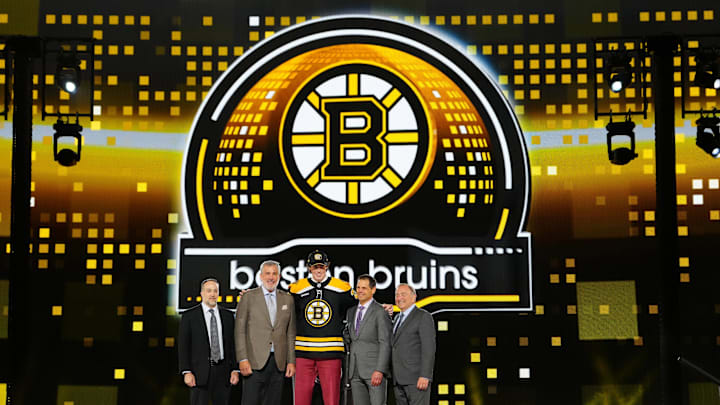The Boston Bruins landed the seventh overall pick in the 2025 NHL Draft after the ping pong balls didn’t bounce their way, dropping two spots from their projected fifth position. With the draft set for June 27-28, 2025, in Los Angeles, general manager Don Sweeney faces a critical decision: keep the pick and draft a high-potential prospect or trade it to address immediate roster needs.
The Case for Trading the #7 Pick
The Bruins’ 2024-25 season exposed significant gaps that need to be addressed immediately, particularly at center, with the team struggling to replace retired stars Patrice Bergeron and David Krejci. Elias Lindholm, acquired last season, underperformed as a top-six center, and the prospect pool lacks a clear franchise-altering talent. Trading the #7 pick could net a proven NHL center or a package including a top-four defenseman, addressing these weaknesses now.
Another reason to consider trading the pick is the uncertainty of this years draft class. The 2025 draft class, while featuring standouts like Matthew Schaefer and Michael Misa, is considered less predictable beyond the top two picks. Some analysts note a drop-off in elite talent after the top five, meaning the #7 pick may not yield a game-changer. Trading the pick for a known quantity such as a young, established player under team control reduces risk and aligns with the Bruins’ need to compete sooner rather than later.
If this was the route they take a player like Anaheim’s Trevor Zegras comes to mind. Zegras is a dynamic young center who could thrive in a new environment. Acquiring him would likely require a significant package, including the #7 pick as well as prospects that the Bruins are short on.
Another option on the table is to trade the #7 pick to accumulate more draft capital. Sweeney has indicated openness to exploring trade options, including moving up in the draft or trading for assets. The #7 pick holds significant value, especially for teams like the Columbus Blue Jackets, who might offer picks #14 and #20 to move up. Such a deal could provide Boston with additional draft capital to address multiple needs or facilitate a separate trade for a roster player.
The prospect pool for the Bruins has dwindled due to poor drafting and trading early round draft picks at the deadline in recent years so restocking with multiple first round picks is appealing.
The Case for Keeping the #7 Pick
Despite the lottery setback, the #7 pick offers a chance to draft a high-upside player like James Hagens, Caleb Desnoyers, or Porter Martone, who could become a cornerstone for the franchise. Hagens, a dynamic center compared to Jack Hughes, could address Boston’s long-term need at the position. Desnoyers, a 6-foot-2 QMJHL centerman with 84 points in 56 games, offers size and scoring. Martone, a power forward, brings physicality and offensive flair with 98 points in 57 games in the OHL.
NHL draft history suggests the seventh pick often yields quality players, even if their impact isn’t immediate. Notable #7 selections include Shane Doan (1995), Jason Arnott (1993), and Quinn Hughes (2018). Keeping the pick ensures Boston adds a cost-controlled talent to a roster facing salary cap constraints.
Trading the pick risks continuing Boston’s cycle of short-term fixes, as seen in past deals that depleted draft capital. With core players like David Pastrnak and Charlie McAvoy in their primes, the Bruins need to balance competitiveness with sustainability. Drafting a high-potential player at #7 could provide a long-term solution, reducing the need to overpay in free agency or trade markets.
Sweeney’s approach will rely on the trade offers available and the Bruins’ offseason priorities. The team’s prospect pool, ranked among the NHL’s weakest, benefits more from adding a high-end talent than from incremental roster upgrades. However, if a trade can secure a young, top-six center or a defenseman with term, the immediate boost might outweigh the draft’s uncertainty.
Keep #7 or Trade #7?
The Bruins should lean toward keeping the #7 pick unless an exceptional trade offer emerges. The opportunity to draft a potential top-six center or top-four defenseman aligns with Boston’s need to rebuild its prospect pool and plan for life after David Pastrnak and Charlie McAvoy. While trading the pick could address immediate gaps, the risk of missing a high-upside talent outweighs the benefits unless the return includes a young, proven player or significant draft capital.
Sweeney’s due diligence in exploring trade options is wise, but the smart play is to draft a player who can grow into a franchise pillar, ensuring the Bruins avoid another season praying for the ping pong balls to bounce their way.
